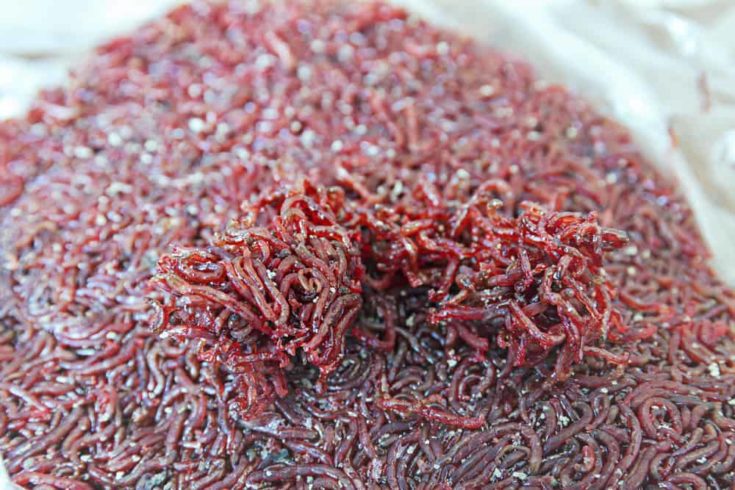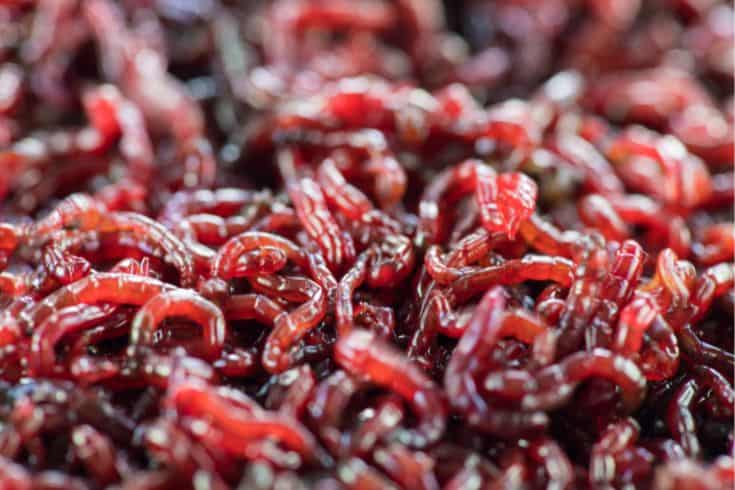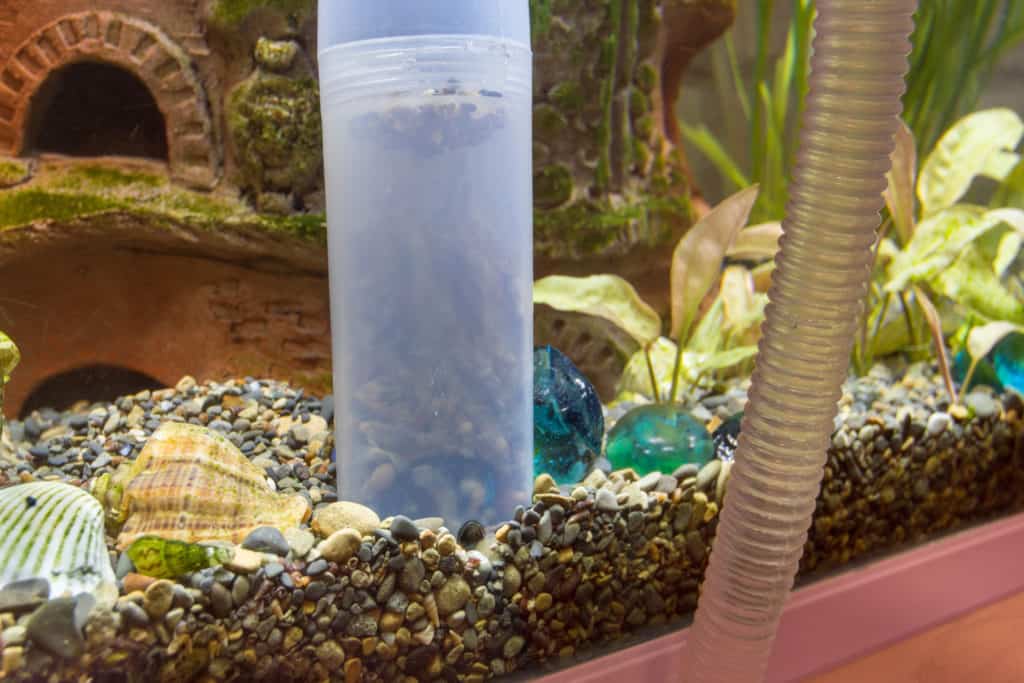As far as carnivorous fish species go, bettas are some of the most unique and easily recognizable. These beautiful fish are native to the rice paddies and rivers of Southeast Asia, where they feast on a variety of protein sources stumbled upon in the wild. While bettas in the wild may eat just about anything, those kept as pets are much more particular regarding their diet.
In the home aquarium, bettas are typically fed a diet of pellets or flakes, with the occasional tasty snack thrown in for good measure. Bloodworms are one of the most popular snacks for bettas. Fish love bloodworms, and aquarium fish owners appreciate that they provide a range of benefits. But what are bloodworms, exactly? Keep reading to find out everything you need to know!
What Exactly Is A Bloodworm?
Bloodworm is a general term used to refer to different species. The most common type of bloodworms is midge flies’ larvae, tiny insects resembling mosquitoes. These aren’t worms at all – they are simply a form of larvae with a reddish, worm-like, segmented body. The adult form of these “bloodworms” is a small, harmless fly.
If you think an infestation of midge flies in your fish tank is necessary to obtain bloodworms, don’t worry – another type of “bloodworm” is the Glycera – a group of bristle worms that thrive in marine conditions. These have pale, translucent skin that allows the hemoglobin to show through, giving them a reddish appearance.
Unlike midge fly larvae, bristle worms can reach lengths of up to 14 inches at their full size. Betta hobbyists are unlikely to introduce giant versions of these worms to their fish tank, but the smaller ones make a nutritious treat for bettas. Nothing sends a betta into hunting mode like the sight of a wriggling bloodworm!
Are Bloodworms Good For Bettas?

With so many food options for tropical fish available on the market, you might wonder if bloodworms are worth feeding to your betta. After all, the last thing hobbyists want to do is introduce something to their betta fish diet, only to later discover that it was a complete waste of money.
The good news is that bloodworms are an excellent source of nutrients and protein for bettas. Their protein content is particularly high, making bloodworms a superfood of sorts that will keep your betta fish strong and well-nourished. In addition to being high in protein, bloodworms are also a good source of essential lipids and fatty acids.
With every meal, you want to ensure that your betta receives a balance of nutrients. While pellets and flakes provide a good foundation, bloodworms are an excellent supplement that keeps your betta fish healthy and active.
Types of Bloodworms For Betta Fish
Bloodworms may come from different sources, but hobbyists generally use a combination of live, freeze-dried, and frozen bloodworms to feed their bettas. Each type of bloodworm has its own set of benefits and drawbacks, which we’ve outlined below:
Freeze-Dried Bloodworms

Freeze-dried food has exploded in popularity in recent years, and for a good reason. This type of food is easy to store, lasts a long time, and is typically less expensive than live or frozen food.
Freeze-dried worms are no different. These are a great option for betta owners who want to feed their fish a nutritious snack without breaking the bank. Freeze-dried bloodworms are also widely available – your local pet stores will likely have some in stock, and if not, you can always buy some online. We like this simple, fuss-free Tetra BloodWorms Freeze-Dried Treat.
The main downside of freeze-dried bloodworms is that the freeze-drying process can cause them to lose some of their nutritional value. In addition, many bettas prefer the taste and texture of live or frozen bloodworms. If your betta is a picky eater, you might have to do some trial and error to figure out which type of bloodworm he or she prefers.
Frozen Bloodworms

If the idea of feeding your betta fish freeze-dried food doesn’t sit well with you, then you might want to try frozen bloodworms instead. You can generally buy these in the form of a large frozen slab, though cubes are also available. Generally speaking, however, each frozen cube will contain far too many bloodworms for a single betta fish meal.
One advantage of frozen bloodworms is that they are usually very fresh and flash-frozen soon after being harvested. This freezing process helps to preserve their nutritional value, making them a good choice for bettas that are growing or need a little extra boost. The defrost process is also relatively fuss-free, as you can simply place the frozen block in a cup of warm water to thaw it out.
Although they are a bit more expensive than freeze-dried bloodworms, frozen bloodworms are generally still less expensive than live ones. In addition, they can be stored for a longer period of time compared to their live counterparts. Freeze-dried worms will always be your best bet when it comes to storage, but frozen bloodworms are a close second.
Live Bloodworms

Last but not least, we have live bloodworms. These are generally considered the gold standard when it comes to feeding bloodworms to bettas, as they allow your bettas to enjoy these treats in their natural form. People generally raise their own bloodworms or purchase them from a reputable seller or bloodworm farm.
The main advantage of live bloodworms is that they are the most nutritious option for bettas. Freshly harvested bloodworms are packed with nutrients, and bettas seem to love their taste and texture. They are also fairly easy to store, although you must remember that they have a very short shelf life.
On the other hand, parasitic infections are greater in betta fish that enjoy live worms regularly. If you do choose to feed your betta live bloodworms, it’s important to take some precautions. First, ensure that the worms are raised in clean, fresh water. Second, ensure that your suppliers have a reputation for good husbandry.
How To Feed Bloodworms to Bettas
Now that we’ve gone over the different types of bloodworms, it’s time to talk about how to actually feed them to your betta fish. To keep your fish healthy, it’s important to follow a few simple guidelines. We’ll discuss these below:
Feed the Right Amount
It’s easy to go overboard when feeding your betta fish bloodworms. After all, they’re delicious! However, it’s important to remember that bloodworms are a treat, not a staple.
As such, you should always feed your fish in moderation to prevent digestion issues. Swim bladder disease and constipation in betta fish are both fairly common, and overfeeding can contribute to these problems.
A good rule of thumb is to offer your betta no more than one eyeball-sized portion of bloodworms. This usually comes out to around 2 bloodworms per meal, depending on the size of the worms.
If you’re feeding freeze-dried bloodworms, you’ll need to rehydrate them before feeding, as they will expand in size once hydrated. You don’t want to overfeed your fish, so be sure to avoid caution.
Some people assume that because they keep their fish active with a lot of swimming, they can get away with feeding them more. Unfortunately, this isn’t always the case. Bettas have small stomachs, so they can only eat so much at a time.
In addition, bloodworms are very rich in protein and fat, which means that a little goes a long way.
Limit Feeding Frequency
We’ve waxed lyrically about the nutritional benefits of bloodworms, but it’s important to remember that they should only be fed as an occasional treat. You shouldn’t feed your betta bloodworms daily or as a staple meal. In fact, most experts recommend that you feed betta fish bloodworms no more than twice per week.
Two meals per week may seem dismal, but remember that bloodworms are extremely rich in protein. Your fish can only absorb so much protein at a time, and introducing excess nutrients can put stress on their digestive system. There is simply no point in spending a good deal of money on fish care, only to end up overfeeding your fish and making them sick.
In addition, feeding bloodworms too often can cause your fish to become spoiled and fussy. Fish feed should make up the bulk of your betta’s diet, so causing them to develop a taste for bloodworms can make it difficult to get them to eat other types of food. This can lead to malnutrition, as your betta may not be getting all the nutrients they need from their diet.
Remove Uneaten Food

It may seem a little obvious, but it’s a bad idea to leave excess food to rot in your tank. Not only is this unsightly, but it can also lead to water quality issues. Bloodworms in particular, are notorious for causing ammonia spikes because they decompose at a rapid rate. This spells trouble for the delicate betta, as they are highly susceptible to ammonia poisoning.
To avoid this problem, removing any bloodworms that your betta doesn’t eat within a few minutes is best. This can be tricky, as bettas are known to spit out food that they don’t like. If you’re struggling to remove the uneaten bloodworms, you can try using a turkey baster or siphon to suck them out of the water.
Sometimes, you may miss a few bloodworms, and they’ll end up decomposing in your tank. Therefore, it’s important to test the ammonia levels in your water on a regular basis. This will help you to catch any spikes early and take corrective action if necessary. In addition, if you notice cloudy fish tank water signs, it’s a good idea to do a water change as soon as possible.
Supplement With Other Food Sources
As we’ve mentioned, bettas should only be fed a couple of bloodworm snacks per week. The rest of their diet should consist of high-quality fish feed, fish flakes, and other protein sources such as brine shrimp and tubifex worms. Even carnivores need a balanced diet made up of healthy foods, and this is especially true of bettas.
If you’re not sure what kind of betta food to use, look for something with a crude protein content of around 30%. This will ensure that your fish is getting all the nutrients they need, without overloading their system with protein. Some fishkeepers also feed half a pea to their bettas a couple of days per month, as this provides them with much-needed fiber.

Bettas may be picky eaters, but resist the urge to give in to their preferences and only feed them bloodworms. While they may enjoy the occasional treat, too many bloodworms can lead to health problems further down the line. Stick to a healthy, balanced diet, and your betta will thank you for it in the long run!
Can Bettas Catch A Disease From Bloodworms?
As we’ve mentioned, bloodworms increase the risk of disease in bettas if not handled correctly. Many aquarium hobbyists have had bad encounters with bloodworms, as they can be carriers of harmful bacteria and parasites. These make their way into the tank water, and from there, into the betta’s body. Some common diseases that can be transmitted in this way include:
Fin Rot
Caused by bacteria such as Pseudomonas and Aeromonas, this disease leads to the betta’s fins becoming frayed and disintegrating. Bloodworms are often blamed for fin rot outbreaks, as they can carry these harmful bacteria. The betta’s fins will start to turn black or brown at the edges, and the disease will progress from there if left untreated.
Dropsy
This is a disease that can have many different causes, but one of the most common is a bacterial infection. As with fin rot, bloodworms can introduce harmful bacteria into the tank water, infecting the betta. Dropsy is characterized by the swelling and “pineconing” of the betta’s scales, and it can be fatal if left untreated.
Flukes
Flukes are parasitic flatworms that attach themselves to the betta’s body and feed off their blood. They’re usually introduced into the tank via infected live food, such as bloodworms.
They look like small white spots on the betta’s body; if left untreated, they can cause severe damage and even death. Flukes cause irritation and inflammation, eventually leading to organ damage and death.
To protect your betta from these diseases, taking proper precautions when feeding them bloodworms is important. Only buy bloodworms from a reputable source, such as a pet store or online retailer.
Avoid buying them from street vendors, as these are more likely to be contaminated. And if you’re raising your own bloodworms, ensure that in clean, sterile conditions.
That said, it’s also important to remember that bloodworms are not the only potential source of disease. Any live food you introduce into your tank has a risk of infections, so it’s important to be vigilant no matter what you’re feeding your fish.
If you’re ever in doubt, give your betta a freeze-dried treat instead. You lose a little of the nutritional value, but it’s a small price to pay for peace of mind!
Wrapping Up
We hope this article has helped you understand a little more about bloodworms and their place in the betta diet. While they can be a great source of protein, it’s important to remember that they should only be fed in moderation. A couple of bloodworms per week will suffice, and the rest of your betta’s diet should be made up of high-quality fish food.
If you have any questions or would like to share your experiences with feeding bloodworms to bettas, please leave a comment below. We would love to hear from you! And if you know someone who is considering adding bloodworms to their betta’s diet, be sure to share this article with them.
Thanks for reading!
